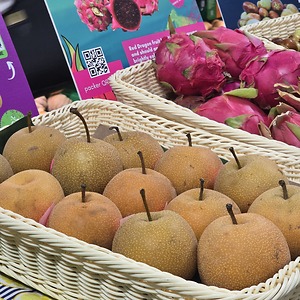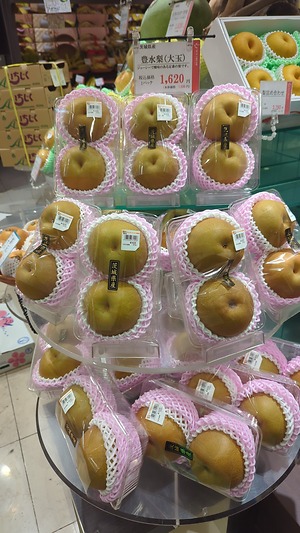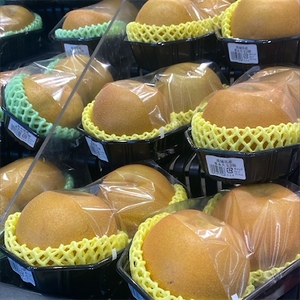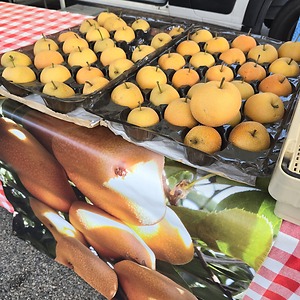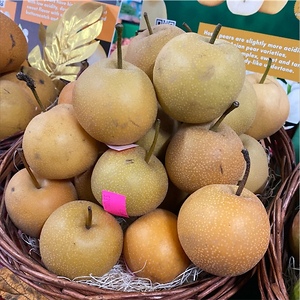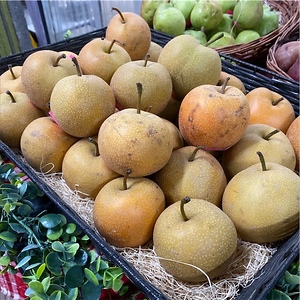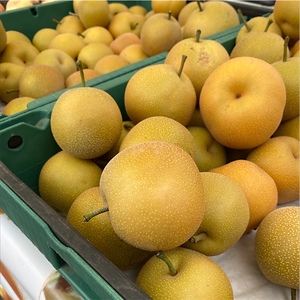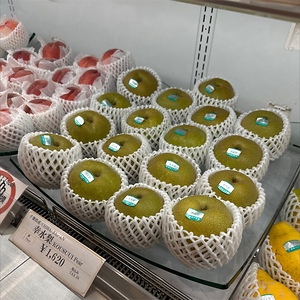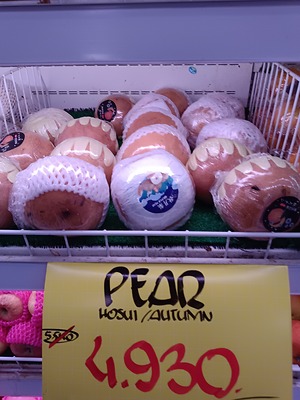

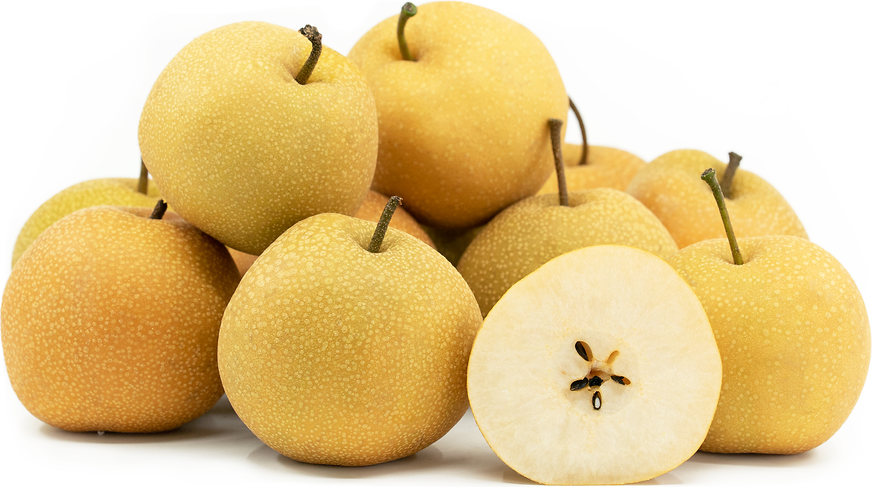
Hosui Asian Pears
Estimated Inventory, cs : 0
Description/Taste
Hosui pears are medium to large fruits, averaging seven centimeters in diameter, and have a round to ovate shape attached to thick, fibrous brown stems. The skin ripens from green when young to gold-bronze with maturity and is firm, chewy, and russeted with prominent pale lenticels. Underneath the surface, the flesh is dense, crisp, fine-grained, and ivory to off-white, encasing a small central core filled with black-brown seeds. Hosui pears are slightly more acidic than other Asian pear varieties, developing a complex, sweet and tangy flavor with a brandy-like undertone.
Seasons/Availability
Hosui pears are available in the early fall through winter.
Current Facts
Hosui pears, botanically classified as Pyrus pyrifolia, are a famous Asian pear variety belonging to the Rosaceae family. The round, juicy fruits are a fairly new cultivar developed in Japan in the 1970s and are considered a dessert pear, primarily consumed fresh but sometimes utilized in cooked preparations. The name Hosui roughly translates to mean “much water,” a descriptor for the fruit’s juicy flesh and was selected as an improved variety of kosui pears with a larger size and extended storage capabilities. Hosui pears are one of the most popular cultivars in Japan and are also an early to mid-season variety grown in home gardens. The trees reach up to four meters in height and are heat and drought tolerant, highly prolific, and ornamental when in bloom. Outside of Japan, Hosui pears are the preferred Japanese variety cultivated in California and are sought after by pear enthusiasts through local farmer's markets, specialty grocers, and Asian markets.
Nutritional Value
Hosui pears are an excellent source of vitamin C, an antioxidant that strengthens the immune system, boosts collagen production within the skin, and reduces inflammation. The fruits are also a good source of fiber, which is primarily found in the skin, and contains minerals such as calcium, phosphorus, potassium, copper, and manganese to protect bone growth, balance fluid levels, and encourage the metabolization of various nutrients in the body.
Applications
Hosui pears are best suited for fresh applications as their sweet and crisp flesh is showcased when consumed straight, out-of-hand. The fruits can be eaten with the skin on, discarding the core, but in Japan, it is preferred to peel the skin before consumption. Once the pear is peeled, the fruit is cut into slices and artfully arranged on a decorative plate. Hosui pears are also chopped and added to green and fruit salads, served with cheeses on appetizer platters, juiced and incorporated into beverages, or cooked into jelly for use in desserts and boxed sweets. Beyond fresh applications, Hosui pears are popularly used in baked preparations and can be cooked into muffins, bread, cakes, pies, and tarts. The fruits can also be cooked into a syrup for iced tea, poached for a sweet treat, or stuffed and baked for a rich dessert. Hosui pears complement ingredients such as meats, including duck, beef, pork, and poultry, fruits such as strawberries, blueberries, and citrus, snow peas, daikon radish, arugula, fennel, vanilla, ginger, and honey. Whole, unwashed Hosui pears will keep 1 to 3 months when stored in the crisper drawer of the refrigerator.
Ethnic/Cultural Info
The National Agriculture and Food Research Organization, or NARO, is Japan’s largest research institute, employing over three-thousand breeders, scientists, and staff members. The organization was established in 1983 and has integrated various research institutes throughout Japan to create a program with multiple, specialized locations under the NARO name. Within NARO, the Institute of Fruit Tree and Tea Science has developed some of Japan’s most famous fruit varieties, including fuji apples, shine muscat grapes, and akatsuki peaches. The Institute of Fruit Tree and Tea Science also created kosui and Hosui pears, which are the two most popular varieties in Japan and account for approximately sixty percent of the pears produced for the Japanese market. NARO continues to research, test, and advance the study of fruits to create varieties with improved characteristics for worldwide cultivation.
Geography/History
Hosui pears were developed in Japan in 1972 at a horticultural research station, currently known as the Institute of Fruit Tree and Tea Science within the National Agriculture and Food Research Organization, or NARO. The variety was created from a cross between hiratsuka and kosui pears and was bred to exhibit improved flavor, texture, and resistance to black spot disease. Since its introduction into commercial markets, Hosui pears have become one of the top Japanese pear varieties and is recognized for its unique flavoring. Today Hosui pears are grown throughout Asia and are also found in California, select regions of Europe, and Australia. The variety is commercially grown through specialty farms and is also a popular home garden variety.
Recipe Ideas
Recipes that include Hosui Asian Pears. One
| Vegetarian Times |
|
Asian Pear Salad with Gorgonzola and Toasted Pistachios |
| Betty Crocker |
|
Asian Pear Pie |
| The Kitchn |
|
Asian Pear Sparkler |
| Bake Space |
|
Asian Pear Pasta |
| Saveur |
|
Pickled Asian Pears with Lemon |
Podcasts



